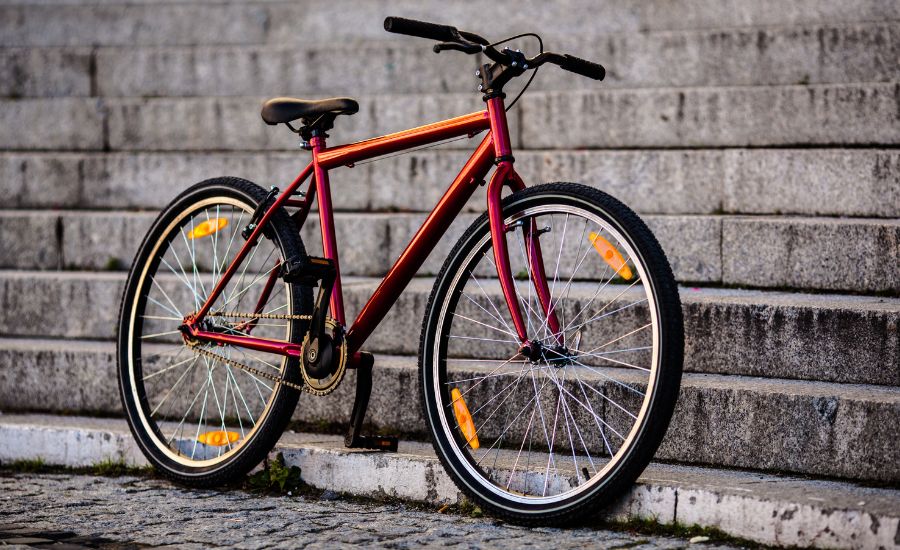How long do bikes last? A properly maintained bike lasts even longer than it is specified in the operating instructions.
Depending on the type of bicycle, the average service life ranges from 5 to 20 years.
Last but not least, the quality of production, the price of the bike, wear and tear, and regular maintenance also play a role.

Bikes’ types and their lifespan
Look through the description below to know the average lifespan of different types of bicycles:
Road Bikes (5-10 years) are lightweight bicycles designed for riding at high speed on roads and gravel paths.
Road bike tires are designed thinner than mountain bike tires and have less tread.
Mountain Bikes (20+ years) differ from road bikes mostly in terms of their geometry.
A mountain bike is with large-volume tires with knobby tread and is specially designed to help you conquer the toughest trails, and rigid terrains and enjoy smoother off-road trips
Electric Bike (3-5 years) powered by electricity and provide great power and support on uphill climbs. Electric bikes are in different categories – mountain bikes, commuters, cargo, gravel, road, and city.
Folding Bikes (15-20 years) designed for long traveling with a foldable frame which easy to reassemble and store.
As they are lightweight and easily foldable, they’re perfect to take to and from the train station, office, or any other place as you can fold up them small enough for you to carry.
Hybrid Bike (5+ years) combines features of different bike types and is designed for town rides and off-road trips.
The hybrid bike is a mix of mountain, road, and touring designs. It is also known as a fitness bike. It is one of the most versatile bicycles on the market with specific features and a wide range of uses.
BMX (2-6 years) are small-framed bikes popular among bikers who love doing tricks. BMX (bicycle motocross) is great for racing that resembles motocross with dirt tracks and jumps.
Single Gear Bike (5+ years) has single fixed gear and single speed, as the back wheel moves the same way the pedal does.
It is perfect for riding through the streets or the local velodrome. A fixed-gear bicycle is the most simple bike on today’s market.
Tandem Bikes (10+ years) accommodate 2 or more people and can be used by people with disabilities, kids, and elderly people.
A tandem bicycle helps to expend twice less effort as pedaling alone on the same distance. The demand for tandem bikes is gradually growing.
Touring Bike (5+ years) is a tough bike designed with multiple attachments both front and back for carrying heavy loads. You can travel everywhere while carrying everything you need for days or even weeks.
A typical touring bike looks like a standard road bike and has the same basic shape. But it has a more upright riding position and a geometry that helps maintain stability while carrying lots of weight.
Fat Bike (5+ years) is a bike with fat wheels that can ride past obstacles easily, for example, on snowy, muddy terrains with maximum stability.
You can ride everywhere – dunes drift, snow, and sand is not a problem as fat tire bikes give you the incredible traction and control that lets you tackle any obstacle.
How often should I replace my bike?
So, as you can see, different bike types last differently. You can replace your bicycle right after the average lifespan ends. But there are other reasons you should consider before replacing.
The quality of the production is also very important. Besides, the price depends on quality too.
Do not spare money if you are going to buy a good bike. It is of better quality as is made with durable materials and enduring components which work better and last longer.
This does not mean that once you buy a bicycle, you will ride it forever. Don’t forget about regular maintenance and replacement of components that wear out over time in one way or another.
How many miles will a bike last?
Again, everything depends on the bike, its quality, frequency of use, and maintenance.
On average, a good bicycle lasts for 30,000-50,000 miles which can be compared to five years of everyday or frequent use.
But to be correct, it is worth saying that more attention you should pay to the bike’s more delicate components and their maintenance.
How often to replace bike components?
After some years of active bike use, in many cases, everything you need to do is replace some components and continue your riding.
Even though the bike frame is in excellent condition, some bike parts and components of a drive train need to be replaced regularly to ride safely.
Even if the drivetrain is pretty durable, it is possible to last an even longer time. Your drivetrain works well a few hundred miles longer if to replace the bike chain every 2000 to 3000 miles.
If you ride with a damaged or worn-out chain, you’ll damage the chainrings and cassette, and shorten their lifespan.
- Brake Pads. They should be changed very often, every 500-1,000 miles, or every month of active riding.
Brake pads are the most sensitive friction part in a braking system and as you press the brake pedal down very often, you should replace them more often than any other component.
- Bike Chain. Replace it every 2,000-3,000 miles, or, in other words, every few months if you use your bike regularly.
A bike chain needs special care. Lubricate it regularly, but not when it is dirty. The chain must first be cleaned, wiped dry, and only then lubricated. Such simple actions extend the life of this component.
- Bike Cassette. Change it every 4,000-6,000 miles or every other season.
- Freehubs. Don’t try to service them, just replace them every 3,000-5,000 miles, or once a season.
- Metal forks can last at least 3 years if it concerns hard usage but mostly they can last almost forever if it’s taken care of. You can replace many other components but the metal fork is like a new one.
- Bike wheels/bike tires. Change them every 3,000-6,000 miles, or as soon as you noticed tread wear and tear, rubber cracks, sidewall cuts, and low performance.
- Belt Drive. Change it not very often, every 20,000 miles, or even less.
- Spokes can last 186,400-200,000 miles, but they may last forever in quality wheels.
- Aluminum Handlebar/Aluminum Crankset. Replace it every 18,600 miles, or every two years.
How long bike frames can last?
The bike frame is the basic component of the bike. All other parts are attached to the bicycle frame.
And if the various components have to be changed quite often, the bike frames last forever with proper bike maintenance and proper storage conditions.
The material from which the bicycle frame is made is also important. Some materials are very strong, but overall the bike is heavier. Lightweight bikes may be made of less durable materials and therefore require more care.
Steel bike frames
Steel is one of the strongest materials and the most widely used in the world.
Steel is a super-resistant alloy of iron and carbon, which has increased corrosion resistance.
Steel bike frames last a long time if the bicycle is stored in a closed room with low humidity.
Otherwise, the chrome coating, which is applied on top of the steel alloy, may begin to peel off and the bike has an unattractive rusty appearance.
Steel frames can last from 7 years and more, even with daily use and high mileage.
Most road bikes are made of steel. Steel bikes are heavier than most bikes of other materials and slower, so you have to make effort on hilly terrain.
Carbon fiber frames
A carbon fiber frame is lighter than a steel frame. Carbon fiber can be shaped freely and designers can optimize the bicycle down to every millimeter. As carbon is very light, racing bicycles are often made of this material.
Because carbon fiber bikes are more complex to manufacture, they are considered high-quality products.
If they are not damaged, carbon frames can last forever. But most manufacturers recommend replacing the frame after 6-7 years.
If a carbon frame is damaged, you should dispose of it to avoid its sudden break under certain circumstances.
Aluminum bike frames
Aluminum is one of the lightweight materials, that is prone to cracks and tears.
The average lifespan of aluminum bikes is at least 5-10 years. Depending on other factors, aluminum frames can wear down faster.
Aluminum bikes are suitable for sporty riding and are not an expensive alternative to carbon bikes. They’re perfect for beginners looking to get their first bike.
Advanced hobby cyclists who are looking for high quality at a good price find what they are looking for in a lightweight aluminum road bike.
The material is of high quality and almost corrosion-free. With appropriate care, aluminum frames do not rust.
Coupled with its durability, aluminum is a reliable and durable material that is heavier than carbon but lighter than steel.
Titanium frame
Titanium is as strong metal as steel but less dense and thus much lighter. That’s why it is part of many alloys with aluminum and iron.
Titanium bikes serve forever. At least not less than 20 years.
Titanium bike is resistant to corrosion, unlike steel bike. A titanium bicycle frame also does not fatigue, unlike an aluminum frame.
Moreover, with proper care and maintenance, the titanium bike lasts much longer than a carbon frame bicycle or any kind of steel bike. Not to mention the aluminum bike frame. Titanium bike’s quality is beyond the competition.
How long do cheap bicycles last?
Cheap bikes are mostly made from inferior materials, cheap bike components, and with less care.
They wear out sooner than high-quality bicycles, thus, as long cheap bikes can’t last even with the best care and maintenance.
You have to service such a bicycle and replace worn components more often. So, think carefully before buying a cheap bike.
How old a bicycle should be considered vintage?
A bicycle considered vintage depending on how many years ago it was manufactured. A bike that is 25 years old or more is vintage. If the bike is 100 years of age, then it is antique.
In other words, vintage bicycles are usually defined as bicycles that were produced between the 1920s and the 1990s.
Mostly they have been made by hand and constructed with steel.
It is because, in the past, steel was regarded as the best material for bicycle manufacture as it was considered the most responsive, hard-wearing, and versatile material that was readily available.

When should I get a new bike? Conclusion
Let’s summarize everything said in this article.
There is absolutely no need to buy a new bike every 5 years. Constant care and proper storage conditions, combined with the high quality of the bicycle, guarantee a long service life.
However, you should not forget about the periodic replacement of worn elements to secure your trips and avoid accidents related to the untimely replacement of important components.
If you don’t want to do it or just can’t do it, then go to the nearest bike shop for a tune-up a couple of times a year.

